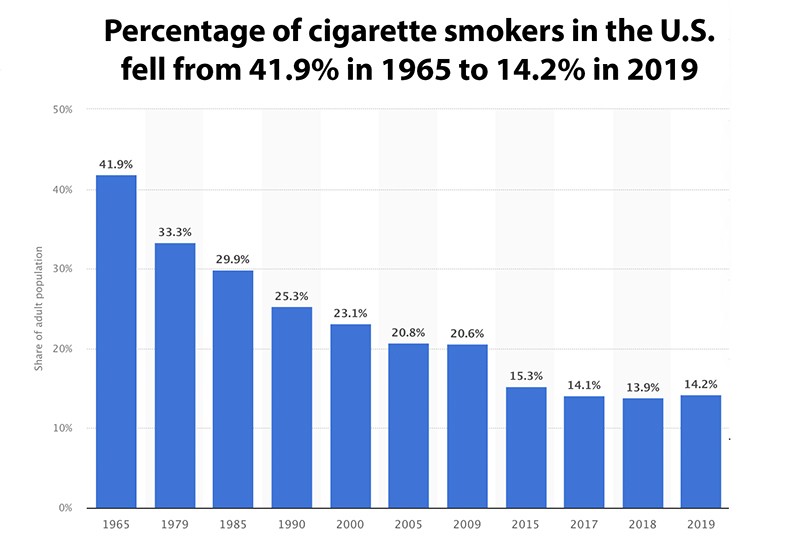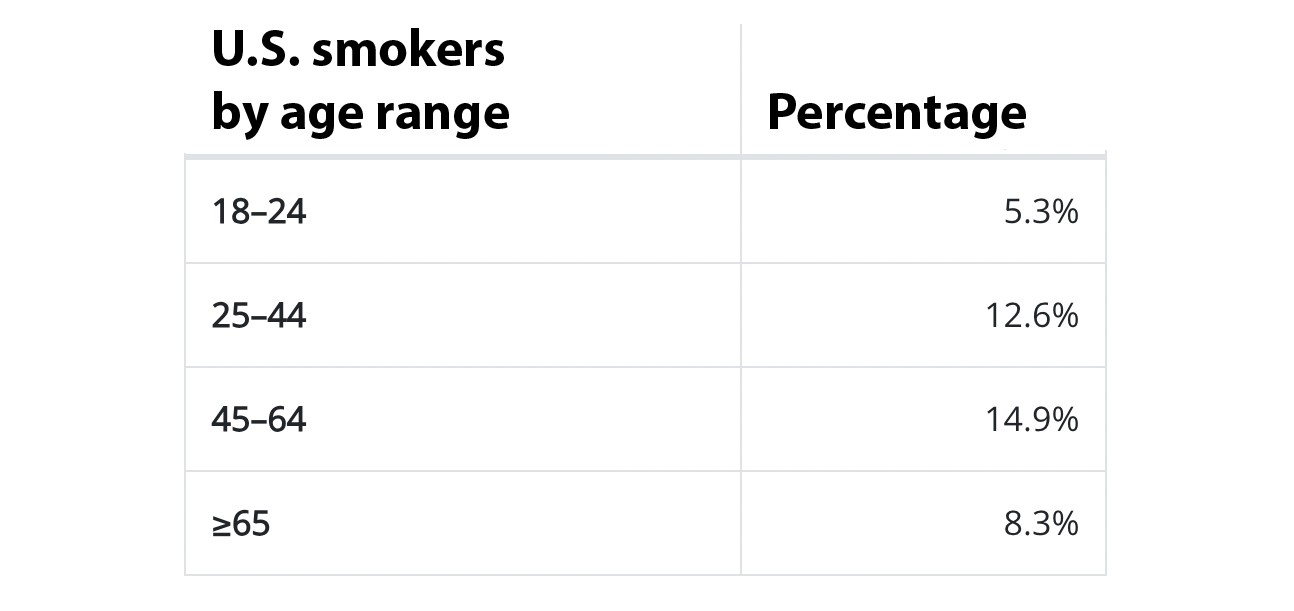
In the United States, 11.5% of adults are smokers, compared to 32.6% of adults worldwide.
This is according to the most recent data from the Centers for Disease Control and Prevention (CDC). The criteria for a “current smoker” is someone who has smoked 100 or more cigarettes over the course of their life, and currently smokes either daily or some days.
America is one of many countries where cigarettes are in decline, but other countries have had even more progress in cigarette smoking reduction.
For example, less than 5% of Swedes are daily smokers, down from 23% of women and 19% of men in 1996. Sweden and the UK, where the cigarette smoking rate is still 12.9%, are among nations that are battling smoking through policy changes and by implementing tobacco harm reduction efforts. One tactic is embracing less harmful alternatives, such as electronic cigarettes and smokeless tobacco.
Let’s take a closer look at cigarettes in the U.S. We’ve gathered 25 interesting statistics that reveal America’s relationship with smoking and how it’s changing.
Key Findings
Smoking cigarettes is deadly, expensive, and prevalent. However, the rate of Americans who are smokers has dropped dramatically since the 1960s.- The percentage of American adults who smoke fell from 41.9% in 1965 to 29.9% in 1985, 20.8% in 2005, and 14.2% in 2019. (Source)

- 28.3 million Americans are smokers. For context, the U.S. Census Bureau reports there are 258.3 million adults and 331.4 million people in the nation. (Source)
- Cigarettes kill over 480,000 Americans annually. (Source)
According to the CDC, over 16 million people in America have a smoking-related disease. (Source) - Smoking is expensive – it cost the U.S. over $600 billion in 2018. This includes approximately $370 billion in lost productivity and $240 billion in healthcare spending. (Source)
Smoking by Demographic
Here’s a breakdown of American smokers by age, gender, race or ethnicity, geographic region, level of education, marital status, income level, and sexual orientation.- Most adult smokers are aged 45-64, at 14.9%. This is followed by the 25-44 age group at 12.6%, the 18-24 age demographic at 5.3%, and adults over age 65 at 8.3%. (Source)

- There is a disparity among male and female smokers, with 13.1% of men currently using cigarettes versus 10.1% of women. (Source)
- By race, white Americans are most likely to smoke, at 12.9%. This is followed by African Americans at 11.7%, Hispanic Americans 7.7%, and Asian Americans at 5.4%. Estimates for Native American/Alaska Native populations were not statistically reliable. (Source)
- People in the Midwest are most likely to be smokers, at 14%. Meanwhile, 12.4% of American adults in the South smoke, along with 10.4% in the Northeast and 8.9% in the West. (Source)
- Generally, the higher the education level achieved, the less likely an American adult is to smoke. However, an adult aged 25 or above with a high school equivalency diploma (GED) is more likely to smoke than an adult with no diploma at all, at 30.7% versus 20.1%. (Source)

- U.S. adults aged 25 and above are least likely to smoke if they have a graduate degree, at 3.2%, followed by adults with an undergraduate degree at 5.3%. (Source)
- Adults who are divorced, separated, or widowed are more likely to smoke than adults with other marital statuses, at 16.8%. Among adults who are single, never married, or not living with a partner, 10.9% are smokers. Among adults who are married or living with a partner, 10.9% are current cigarette smokers. (Source)
- Americans from low-income households are most likely to smoke, at 18.3%. Additionally, 12.3% of middle-income Americans are smokers and 6.7% of Americans from high-income households smoke. (Source)
- Heterosexual or straight Americans are less likely to smoke, at 11.4%. Meanwhile, 15.3% of lesbian, gay, or bisexual Americans are smokers. (Source)
Smoking and Health Statistics
Smoking is the leading cause of preventable death and disease in the U.S. However, Americans with certain physical and mental health problems are more likely to smoke. Here’s a look at the relationship between cigarettes and Americans’ physical and mental health.- 58% of American smokers know their smoking is bad for their health. (Source)
- Cigarette use causes one in five deaths in the U.S. (Source)
- Of Americans who have disabilities, 18.5% are smokers. Meanwhile, only 10.9% of Americans who do not have a disability are smokers. (Source)
- One in five uninsured American adults is a smoker. Meanwhile, 21.6% of those on Medicaid are smokers, 8.6% of those with private insurance smoke, 8.4% of people with Medicare only (aged 65 and older) are smokers, and 13.9% of Americans with other public health insurance are smokers. (Source)
- Americans with disabilities are more likely to smoke, at 18.5%. Meanwhile, 10.9% of Americans who do not have a disability are smokers. (Source)
- The CDC found people who regularly have feelings of “severe psychological distress” are more likely to smoke, at 28.1%, while 10.9% of those who do not have these feelings smoke. (Source)
- Of Americans who have been told by a healthcare provider that they have depression, 19.4% are smokers. Meanwhile, 9.9% of those who have not been given this diagnosis are smokers. (Source)
Smoking Cessation Statistics
Tobacco control policies like monitoring, smoke-free environments, cessation programs, warning labels, mass media, advertising bans, and taxation all have the end goal of reducing smoking and the use of tobacco products among Americans.- 34% of American employers offer cigarette smoking cessation programs – more than weight loss programs (25%) (Source)
- Only 7.5% of adult cigarette smokers, or 2.9 million people, successfully quit each year. (Source)
- People who switch to e-cigarettes are more likely to successfully quit smoking. In a study of 886 participants who wanted to quit smoking, the one-year abstinence rate for those who used e-cigarettes was 18% versus 9.9% for those in the nicotine-replacement group. (Source)
- Nausea is less prevalent among “quitters” who transition to e-cigarettes, at 31.3% versus 37.9% who completely quit nicotine. Also, cough and phlegm production are less among quitters in the first group, but mouth irritation is more common. (Source)
What These Statistics Reveal
Now that we’ve determined what percentage of Americans smoke, we’ve also seen how cigarette use is statistically affected by age, gender, socio-economic factors, physical disability, and mental health. These statistics have revealed how deadly cigarettes can be, the prevalence of diseases related to smoking, and how difficult it is to give up cigarettes.
We’ve also seen how switching to e-cigarettes can increase the chances of successfully quitting and reduce some of the symptoms surrounding smoking cessation.
While vaping is not completely free from health risks, it is embraced by many nations leading the world in tobacco harm reduction efforts. Vapes do not contain tobacco, making e-cigarettes an alternative for ceasing tobacco use.
At VapeSourcing, we will ship to you a wide range of vapes, disposables, vape kits, e-liquids, mods, atomizers, accessories, vaporizers, and hemp. For more information, please see our FAQ or contact us.










































































